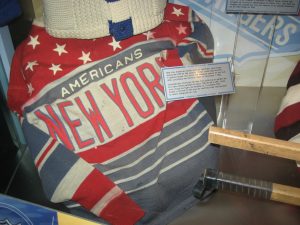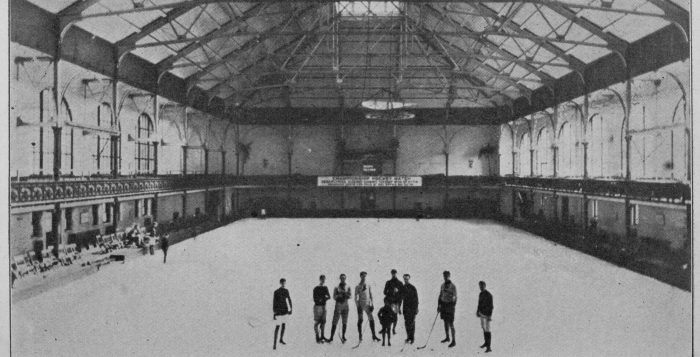This Day in Hockey History – November 7, 1896, 1936, and 1975 – New York State of Mind
(Photo: Spalding’s official hockey guide 1913 archive.org, via Wikimedia Commons)
New York played a big part in three events November 7th, approximately 40 years apart. First, in 1896, the second rink in New York City opened. Second, in 1936, the New York Americans’ game was the first broadcast coast-to-coast on Canadian radio. Third, in 1975, the New York Rangers participated in a legendary trade.
In 1896, Americans were still very new to the sport of hockey. Shortly after the Ice Palace opened in New York City, the St. Nicholas Rink opened at 69 West 55th Street. The skating club had used an outdoor flooded lot until architects Flagg and Chambers (best known for the Singer Building) designed an indoor rink with mechanically frozen (artificial) ice. According to an article written the following January, “The St. Nicholas rink is said to be one of the finest, if not the best in the country, and hockey matches are played there two or three evenings of every week.” The St. Nicholas Hockey Club of the American Amateur Hockey League began their first season with the opening of the new rink. The article gushed, “Great enthusiasm has been shown over the many matches played there this winter. The club has a crack hockey team, which is undoubtedly one of the strongest on this side of the Canadian border-line.”

By Nhl4hamilton | Chit-Chat, from Wikimedia
Commons
The second event took place exactly 40 years later in Toronto, when the Maple Leafs played the visiting New York Americans. In 1936, the Canadian Broadcasting Company (CBC) replaced the Canadian Radio Broadcasting Commission (CRBC) and Imperial Oil had already become the sponsors in place of General Motors. As an Imperial Oil promotion, the NHL began naming the three stars of the game. The Saturday night radio broadcast of hockey games was called Hockey Night in Canada. Foster Hewitt announced the play-by-play in Toronto. The first home game took place on a Thursday, November 5, 1936, so only the local station broadcast the 3-1 loss against the Detroit Red Wings. The Saturday game against New York was the first transmitted on the “Coast-to-Coast Canadian Network,” and the Americans won 3-2.
For the third November 7th event, the New York Rangers and their 1970s archrival, the Boston Bruins, conducted a crazy-seeming trade. Each team traded one of their most-beloved members to the team that most reviled him. The Rangers traded defenseman Brad Park, who eventually became a Bruins’ fan favorite. The Bruins gave the Rangers the lead scorer in all of the NHL, center Phil Esposito, who within twelve hours of the trade scored two goals and an assist. “It took me probably a year to accept that I wasn’t part of the Boston Bruins anymore,” Esposito said. When he finally learned New York City, he found it “the greatest city and the greatest fans, and we had some good years.” To replace Park (and minor league defenseman Joe Zanussi), the Rangers gained defenseman Carol Vadnais, but he could not fulfill Park’s role. To replace Esposito, the Bruins obtained center Jean Ratelle. With Park and Ratelle, the Bruins made it to the Stanley Cup finals in 1977 and 1978 (but lost both to the Montreal Canadiens). Though the Rangers missed the playoffs in 1976 and 1977, they made it to the finals in 1979 (but lost to the Canadiens). For the rest of the 1970s, the Bruins earned more points than the Rangers and defeated the Rangers 14 games to 4 with one tie.
Additional Sources:
- J. Parmly Paret, “Ice Hockey, Our Imported Winter Sport,” The Sportsman’s Magazine 1, no. 4 (Jan. 1897):382-389.
- http://hockeythenandnow.blogspot.com/2010/11/
- https://thepinkpuck.com/2018/11/01/this-day-in-hockey-history-november-1-1952-its-hockey-night-in-canada/
- https://thepinkpuck.com/2018/10/18/this-day-in-hockey-history-october-18-1979-tipping-our-hats-to-esposito/















[…] most goals and most points in a single season (1970-71). Esposito could not keep No. 7 upon being traded by the Bruins to the New York Rangers in November […]
[…] https://thepinkpuck.com/2018/11/07/this-day-in-hockey-history-november-7-1896-1936-and-1975-new-york… […]